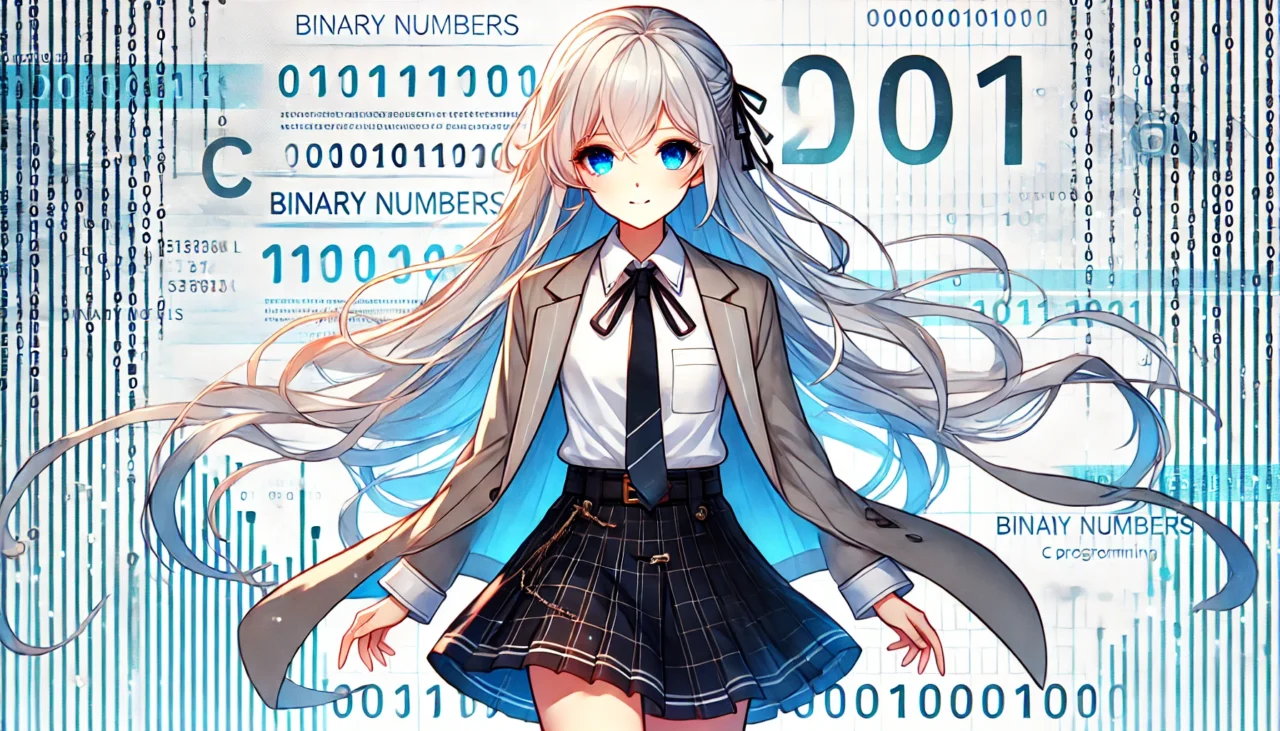- 1 1. Introduction
- 2 2. Basics of Number Representation in C | Decimal, Hexadecimal, Octal
- 3 3. How to Display Binary in C (with Code Examples)
- 4 4. New Feature in C23: %b Specifier
- 5 5. Visual Guide: Binary Representation and Bitwise Operations
- 6 6. FAQ (Frequently Asked Questions)
- 6.1 Q1: Why doesn’t C have a standard binary format specifier?
- 6.2 Q2: What if I can’t use the C23 %b specifier?
- 6.3 Q3: Is it true that Python and Java can print binary easily?
- 6.4 Q4: Why doesn’t right shift work as expected?
- 6.5 Q5: How can I ensure a fixed number of digits in binary output?
- 6.6 Q6: Do developers really use binary output in real projects?
- 6.7 Q7: Any good resources for learning bitwise operations?
- 7 7. Conclusion
1. Introduction
What is Binary? Why is it Important?
The binary system is the most fundamental numerical representation in the world of computers. Using only the digits 0 and 1, it represents data in memory and the state of hardware. In programming, binary numbers are used in bit manipulation, state management, binary file analysis, and many other scenarios.
C language is widely used for writing efficient programs. However, the standard library does not provide a direct way to display numbers in binary format. In this article, we will explain how to display binary numbers in C language from the basics, making it easy for beginners to understand, while also covering practical code examples and the latest C23 standard.
2. Basics of Number Representation in C | Decimal, Hexadecimal, Octal
Explanation of Standard Format Specifiers
In C, you can use the printf function to print numbers on the screen. Here are the common format specifiers and their usage:
%d: Decimal (default integer representation)%o: Octal (often represented with a leading 0)%x/%X: Hexadecimal (lowercase/uppercase format)
For example, running the following code prints the number in different formats:
#include <stdio.h>
int main() {
int num = 42;
printf("Decimal: %d\n", num);
printf("Octal: %o\n", num);
printf("Hexadecimal: %x\n", num);
return 0;
}Output Example:
Decimal: 42
Octal: 52
Hexadecimal: 2aWhy There is No Binary Format Specifier
The C standard library does not include a format specifier for binary output. The main reason lies in historical design choices. Since C was originally developed for system programming, efficient memory manipulation was prioritized over binary output.
3. How to Display Binary in C (with Code Examples)
Using Bitwise Operations
Binary output in C can be implemented using bitwise operations. Below is an example that prints an 8-bit number in binary format:
#include <stdio.h>
void printBinary(int num) {
for (int i = 7; i >= 0; i--) {
printf("%d", (num >> i) & 1);
}
printf("\n");
}
int main() {
int num = 42;
printf("Binary: ");
printBinary(num);
return 0;
}Output Example:
Binary: 00101010Code Explanation
(num >> i): Shiftsnumright byibits, moving the target bit to the least significant position.& 1: Extracts the least significant bit.printf: Prints each bit in sequence.
This approach is simple, flexible, and works with any integer size.
A Generic Function
For more flexibility, you can create a generic function that supports any bit width:
#include <stdio.h>
void printBinaryGeneric(unsigned int num, int bitWidth) {
for (int i = bitWidth - 1; i >= 0; i--) {
printf("%d", (num >> i) & 1);
}
printf("\n");
}
int main() {
int num = 42;
printf("16-bit Binary: ");
printBinaryGeneric(num, 16);
return 0;
}Output Example:
16-bit Binary: 00000000001010104. New Feature in C23: %b Specifier
Overview of the %b Specifier
Until now, C did not provide a standard format specifier for binary output. However, C23 introduced a new specifier:
%b: Used to display numbers in binary format.
This means you no longer need custom functions with bitwise operations—printing binary can be done easily.
Example: Displaying Binary with C23 %b Specifier
Here is a basic example using the %b specifier:
#include <stdio.h>
int main() {
int num = 42;
printf("Binary: %b\n", num);
return 0;
}Output Example:
Binary: 101010Key Benefits of %b
- Simplicity
- No need for loops or bitwise operations. Clean, minimal code.
- Readability
- Consistent with other format specifiers, making code easier to read.
Compiler Support
Since C23 is new, not all compilers support %b yet. Current status:
- Supported Compilers
- GCC: Partial support starting from version 12.
- Clang: Supported in the latest versions.
- Unsupported Compilers
- Older GCC, Clang versions, and some proprietary compilers are not supported yet.
What If Your Environment Does Not Support %b?
If your compiler doesn’t support C23 or the %b specifier, try these alternatives:
1. Use a Custom Function
Use the bitwise method shown earlier (e.g., printBinary).
2. Use a Third-Party Library
Some libraries, such as glib, provide utility functions for binary output.
3. Upgrade to a C23-Compatible Environment
Consider installing the latest compilers to take advantage of new C23 features.
5. Visual Guide: Binary Representation and Bitwise Operations
5.1 Conversion Flow from Decimal to Binary
Here’s how to convert decimal to binary step by step, using 42 as an example:
Example: Convert Decimal 42 to Binary
42 ÷ 2 = 21 ... 0
21 ÷ 2 = 10 ... 1
10 ÷ 2 = 5 ... 0
5 ÷ 2 = 2 ... 1
2 ÷ 2 = 1 ... 0
1 ÷ 2 = 0 ... 1
--------------
Binary: 101010Reversing the remainders gives 101010, which is the binary representation of 42.
5.2 Visual Explanation of Shift Operations
Right Shift (>>)
Shifts all bits to the right.
- Example: Shifting
101010(42 in decimal) right by 1 →010101(21 in decimal).
Original: 101010
Right >>: 010101Left Shift (<<)
Shifts all bits to the left.
- Example: Shifting
101010(42 in decimal) left by 1 →1010100(84 in decimal).
Original: 101010
Left << : 10101005.3 Bitmasking
Example: Turn On the 4th Bit (OR Operation)
00001010 (Original)
| 00010000 (Mask)
------------
00011010 (Result)Usage: Enables specific bits, commonly used in flag management.
6. FAQ (Frequently Asked Questions)
Q1: Why doesn’t C have a standard binary format specifier?
A:
When C was first designed, performance was prioritized. Decimal, octal, and hexadecimal formats were included, but binary was considered too niche. With C23 introducing %b, binary output is now standardized.
Q2: What if I can’t use the C23 %b specifier?
A:
Options include:
- Write a custom function using bitwise operations.
- Install a modern compiler such as GCC 12+ or the latest Clang.
- Use third-party libraries that provide binary output utilities.
Q3: Is it true that Python and Java can print binary easily?
A:
Yes. Both languages have built-in functions:
Python Example
num = 42
print(bin(num)) # Output: 0b101010Java Example
int num = 42;
System.out.println(Integer.toBinaryString(num)); // Output: 101010Q4: Why doesn’t right shift work as expected?
A:
Two possible issues:
- Signed integers: Right shifting a signed int may preserve the sign bit (arithmetic shift). Use
unsigned intto avoid this. - Invalid shift width: Shifting beyond the number of bits of the type is undefined behavior.
Q5: How can I ensure a fixed number of digits in binary output?
A:
Use a fixed-width function:
void printBinaryFixed(unsigned int num) {
for (int i = 15; i >= 0; i--) {
printf("%d", (num >> i) & 1);
}
printf("\n");
}Q6: Do developers really use binary output in real projects?
A:
Yes, in these scenarios:
- Hardware control (device drivers)
- Binary data analysis (file formats, network protocols)
- Debugging flags and states
Q7: Any good resources for learning bitwise operations?
A:
Recommended resources:
- Books: "C Programming: A Beginner’s Guide" (intro + bitwise ops), "System Programming in C" (practical usage).
- Online: GeeksforGeeks (detailed tutorials), Qiita (Japanese community articles).
7. Conclusion
Summary
This article explained how to print binary numbers in C, from basics to advanced techniques. Below is a comparison of methods:
| Method | Description | Pros | Cons |
|---|---|---|---|
| Custom Function (Bitwise) | Manually implemented | Flexible, works with any bit width | More code required |
C23 %b Specifier | Standard format specifier | Simple, highly readable | Requires C23-compatible environment |
| Third-Party Libraries | Use external utilities | Saves time | May add environment dependencies |
Next Steps for Readers
- Try the code examples in your environment to deepen understanding.
- Apply bitwise operations for flag management and debugging.
Tips for Further Learning
- Review Bitwise Fundamentals
- Study shift operators and logical operations (AND, OR) to improve programming efficiency.
- Experiment with C23 Features
- Test the new
%bspecifier and explore modern C standards.
- Compare with Other Languages
- Try binary output in Python or Java to understand differences with C.



